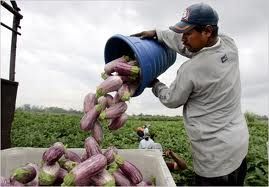Zacatecas, Mexico - When Oscar Reyes heads north for seasonal work every spring, he no longer pays a smuggler to sneak him through the desert past the US Border Patrol. He takes Air Canada.
Reyes earns $10.25 an hour tending grapes and spraying pesticides at a vineyard in British Columbiaís Okanagan Valley, working eight months straight, seven days a week.
He was one of nearly 16,000 temporary workers from Mexico imported by Canada last year, part of a government-to-government agreement that Mexican officials view as a potential model for an expanded "guest worker" program in the United States.
"I come home loaded with money, and I donít have to worry about anything," said Reyes, who is back home for the winter with his family. New toys were scattered all across the living room.
With President Barack Obamaís re-election and the overwhelming support he received from Hispanic voters, expectations are high that he will take up the nettlesome cause of US immigration reform in his 2nd term.
Guest workers program should interest Obama
If so, the most contentious issue is likely to be the fate of the 11 million or so illegal immigrants living in the United States. But the debate is also expected to include proposals for a massive expansion of temporary worker programs to meet future US demand for legal, low-skilled labor.
About 50,000 seasonal agricultural visas are given out by the US each year, nearly all of them to Mexican workers. But United States' farmers, immigrant advocate groups, labor unions, and Mexican officials contend that the current program is a mess: inefficient, bureaucratic, and vulnerable to abuses by swindlers and shady recruiters who charge potential workers thousands of dollars to find jobs for them and prepare their applications for visas.
The frustrations have left many looking north, to Canada, where government officials partner with their Mexican counterparts to recruit workers, expedite visas, guarantee health and safety standards, and coordinate travel arrangements and pay.
They also go to extraordinary lengths to make sure the workers go back to Mexico at the end of the season, raising criticisms that the arrangement treats them as little more than human machines.
Mexicoís new President Enrique PeŮa Nieto said that he has told Obama that his administration is keen to "contribute" to a push for US immigration reform.
Such talk would have been too politically sensitive just six years ago, when the volume of Mexican migrants crossing the border was seen as out of control and the United States Border Patrol was making more than a million arrests a year.
Last year, the Border Patrol made just 340,000 apprehensions, the lowest level since 1971, the result of a tighter US job market, stiffer enforcement, and widespread fears in Mexico of the kidnapping crews and drug gangs who roam the borderlands.
 |
| Migrant farm workers unload eggplants while working at Green Pepper Farms in Florida |
Overall, nearly as many Mexicans are now leaving the United States, whether voluntarily or as deportees, as the number who arrive, a trend that has raised alarms of labor shortages in industries such as food service and farming that are historically dependent on low-paid migrants.
"For anybody who believes that there will be a wild and endless flow of Mexican migrants into the future, thatís just not realistic," said Craig Regelbrugge, vice president for government relations at the American Nursery and Landscape Association, a trade group.
According to industry estimates, US farms hire more than 2 million workers each year, at least half of whom are thought to be in the country illegally.
Farm laborers already tend to earn minimum wage or more, experts say, so employers wouldnít necessarily have to pay higher wages to guest workers than what they currently pay illegal migrants. Still, some US farmers and other employers fear that if the illegal workforce is granted legal status or "amnestied," many of those workers will seek jobs in less arduous occupations.
Between 1942 and 1964, US "Bracero" programs issued 4.5 million visas to Mexican guest workers, and today some of the same United States' labor unions that pushed to have the programs eliminated now support bringing in more guest workers.
"We donít want to see domestic workers displaced, but we also recognize the legitimate needs that US growers have," said Erik Nicholson, national vice president of the United Farm Workers, which wants to unionize the Mexican laborers even before they arrive in the United States. In turn, many growers now back the unionsí insistence that temporary workers have the freedom to change employers, instead of tying their immigration status to a single job.
Under the current US program for seasonal agriculture workers, there is no cap on the number of visas that can be issued. But many United States' employers prefer not to use it as the system is slow and onerous, experts say, and they instead rely on illegal migrants.
Until 2008, Mexican officials in Zacatecas, Mexico, worked with the US Consulate in Monterrey to select temporary workers and facilitate their visa applications. But despite safeguards, officials said that the program was fraught with abuses, including recruiters who would bring workers north and "sell" them to other farms and employers.
When the United States recession hit and demand for seasonal workers fell, Zacatecas officials said they stopped working with the US Consulate. Now they work exclusively with Canada and plan to triple the number of workers who go north, where they earn hourly wages of at least $10, as much as they would make in a day back home. Recruits are screened by Mexican officials based on education level, skills, and health, but 80 percent of the workers are returnees whose employers have requested to bring them back.
At the end of the season last year, all 274 guest workers from Zacatecas returned home from Canada, according to state officials and the migrants.
This, of course, was by design.


